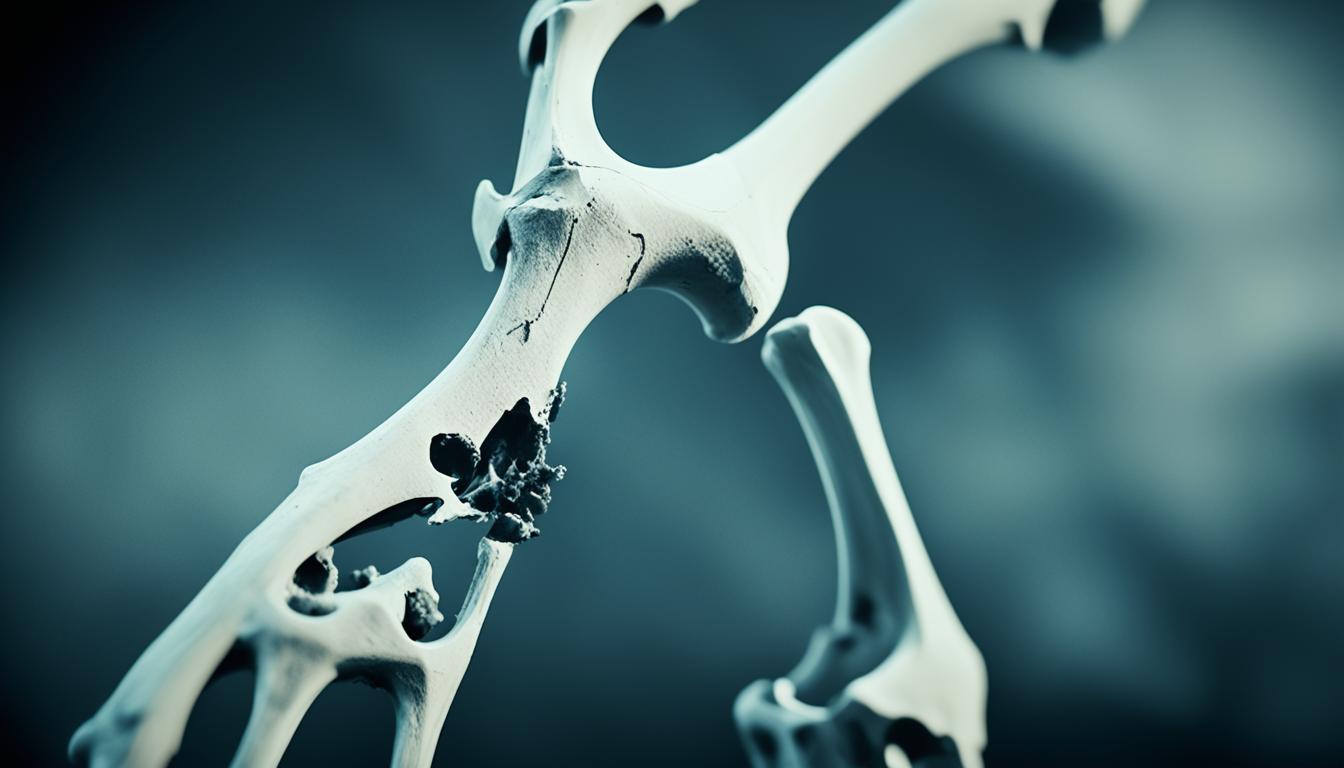Ischemic bone necrosis is a disease that happens when blood flow to a bone part is blocked. This leads to the bone tissue dying. It often affects the ends of long bones, like the femur and humerus. But, it can also develop in the bones of the elbows, ankles, and more.
Pain and less movement in the joint are common symptoms. Doctors can see the issue using x-rays or MRI. We’re not sure exactly what causes it, but injuries and some medicines can increase the risk. So can drinking too much, smoking, and certain health conditions.
Doctors can perform surgeries to stop more bone damage and improve the joint’s function. A new method called stem cell therapy is being tested to treat this severe bone disease.
Key Takeaways:
- Ischemic bone necrosis comes from a lack of blood flow, which kills bone tissue.
- Symptoms include joint pain and a decrease in movement.
- Doctors use x-rays or MRI to find out if you have it.
- Injuries, drugs, too much alcohol and smoking, and some health problems can raise the risk.
- Stem cell therapy is a new hopeful method to treat ischemic bone necrosis.
Symptoms and Diagnosis of Ischemic Bone Necrosis
The main symptom of ischemic bone necrosis is pain in the affected joint. At first, you might feel pain only when using the joint. But, this can later turn into constant pain, even when you’re resting. The hip is often the main joint affected. Pain there usually shows up in the groin or buttock area. You might also have a hard time moving the joint and find it stiff.
Doctors usually spot ischemic bone necrosis with x-rays or MRI scans. These tests can show changes in bone structure and blood flow. Getting a diagnosis early is key. It helps stop more damage and makes treatment more successful. So, recognizing and diagnosing this condition fast means you can start managing it right away.
| Common Symptoms of Ischemic Bone Necrosis | Diagnostic Methods |
|---|---|
|
|
Understanding the Symptoms
Pain is the key symptom in ischemic bone necrosis. As it worsens, the pain can get really bad and stay with you all the time, even when you’re not moving the joint. Where you feel the pain depends on the joint that’s infected. The hip is often affected, causing pain in the groin or buttock area.
Patients also face limits in how far they can move their joint and find it stiff. This makes it hard to do regular activities.
Diagnostic Methods
Doctors often use x-rays and MRIs to check for ischemic bone necrosis. These tests give clear pictures of the bones and blood flow. This way, health experts can see the signs of osteonecrosis.
X-rays highlight changes in bone structure, like thinning and collapse. But MRI scans are more detailed about blood flow and soft tissues. Using both methods helps in a quick and right diagnosis. Then, doctors can make the best treatment plan.
Causes and Risk Factors of Ischemic Bone Necrosis
Ischemic bone necrosis, also known as avascular necrosis, happens when a bone doesn’t get enough blood. Without blood, the bone tissue dies. You can get it from injuries or other things that affect the blood supply to the bone.
Traumatic Osteonecrosis
If you get hurt, like breaking a bone or dislocating a joint, it can lead to ischemic bone necrosis. These injuries can damage the blood flow to the bone.
Nontraumatic Osteonecrosis
But you don’t always need an injury to get avascular necrosis. Some risk factors, like certain medications, heavy alcohol or smoking, and certain illnesses, can also lead to this bone condition.
- Certain Medications: Long-term use of high-dose corticosteroids can mess up blood flow, causing bone tissue to die.
- Excessive Alcohol and Tobacco Use: Too much alcohol and smoking can hurt blood vessels, leading to avascular necrosis.
- Medical Conditions: Diseases like sickle cell anemia or cancer can increase the chances of getting osteonecrosis. They affect blood flow and bone health.
- Medical Interventions: Treatments like chemotherapy or organ transplants may also raise the risk. They can damage blood vessels and how bones get nutrients.
The exact reasons why osteonecrosis develops are not clear. But, it seems to be a mix of genes, how your body processes things, and the world around you. Not everyone facing these factors will get this bone condition. How someone’s body reacts can be different.
Innovative Stem Cell Therapy for Ischemic Bone Necrosis
Stem cell therapy is a new way to treat ischemic bone necrosis. It uses the patient’s own stem cells to help the bone heal. These cells come from bone marrow and fatty tissue.
They can become cells that build bone and they help grow new blood vessels. Plus, they lower inflammation. Early studies show this treatment works well for some people.
It can lessen pain and make moving your joints easier. In some cases, it might even avoid the need for joint surgery. This kind of therapy gives many hope for a better, less surgery-focused future.
Still, we need more studies to be sure about its long-term benefits. Today’s research and tests will help us know more. With more work, this treatment might change how we handle necrosis and bone problems.

